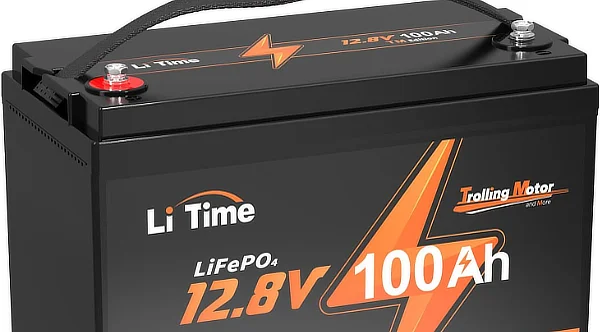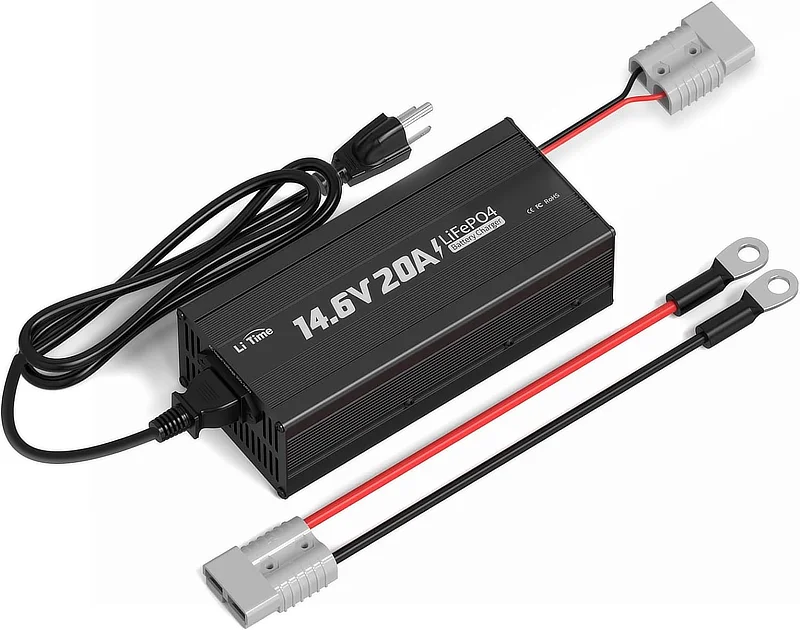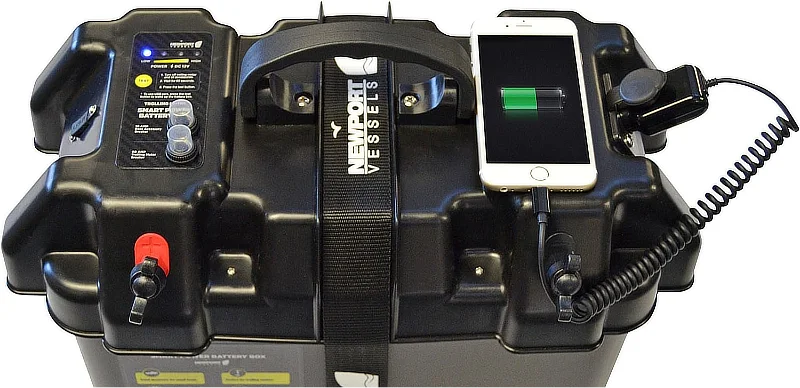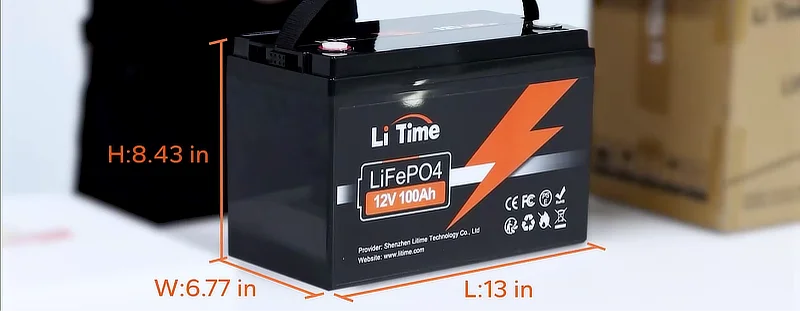I recall the many fishing trips when I had to haul a heavy deep-cycle battery to the boat (and back) for the trolling motor on my Jon Boat (and other boats over the years). Those lead-acid batteries weighed about 70 pounds. Thanks to advances in battery chemistry technology, now you can get a lightweight (deep cycle) trolling motor battery that only weighs about 22 pounds! Thank you!
This type of battery chemistry is perfect for use with a trolling motor. It is superior to the traditional 12V lead acid battery in many ways. Let me tell you about it, and provide my current recommendation…
The battery chemistry is called LiFePO4. Lithium Iron Phosphate. It has become a popular replacement for the traditional 12-volt lead acid battery for purposes such as this. I’ve linked the most popular brand below…
Lightweight 12V Lithium Iron Phosphate Battery – LiFePO4 – Feature Advantages
Here are some reasons why I really like this battery and why it’s one of the best choices for use with a trolling motor…
Lightweight 12V Battery
It’s very lightweight! Typically only 1/3 of the weight of a lead-acid 12V battery equivalent. This one is only 22 pounds while holding an energy capacity of 100 Amp hours. The LiFePO4 battery chemistry packs a lot of power density compared to an equivalent deep-cycle lead acid battery.
As of this post, I’m approaching my mid-sixties. I can still lug around a 70-pound 12V battery. But my oh my… 22 pounds is sure a lot less! Just saying… A lightweight 12V battery has its advantages!
Among the many choices, this one, in particular, is apparently and currently, a great value, while also being the best well-reviewed choice in its category.
(One of many variations shown above)
LiTime – Today’s Most Popular Brand
I researched the companies that make 12-volt deep-cycle lithium Iron Phosphate batteries. It didn’t take long to discover the brand LiTime, which has become an apparent leader in popularity (as of this post). Well-reviewed and reasonably priced, they are my current ‘go-to’ brand and recommendation.
Note… This type of battery may cost a bit more. However, the advantages (including a VERY LONG CYCLE LIFE) are well worth it, in my opinion (more information below).
I may earn revenue from products on this page and participate in affiliate programs at no extra cost to you (Learn More).
Check the following amzn link to this Trolling Motor Battery on their storefront. From there, you can view other variations too.
12V, 100Ah, Deep Cycle, 22lbs

The next battery is the same except it also has Bluetooth connectivity with your phone. This will provide battery status on-the-go…
12V, 100Ah, Deep Cycle with Bluetooth
You will need a battery charger designed for 12-volt Lithium Iron Phosphate batteries. Yes, all this comes with up-front costs. However, the difference in battery life (cycles), and available energy capacity during an outing more than makes up for it when comparing with a lead-acid battery.
I like this battery charger for the 12-volt lithium iron phosphate battery shown above. You can attach a pigtail to the battery which will connect/disconnect from the charger when needed…
14.6V 20A LiFePO4 Battery Charger*
(amzn)

*If using a LiFePO4 battery, ensure the battery charger is compatible.
The cycle Life of LiFePO4 battery is SO MUCH BETTER
There’s another huge reason why I like this battery (the LiFePO4 battery chemistry). Actually, there are two reasons combined into one. The relationship between the 12V battery lifetime number of cycles (cycle life) and the depth-of-discharge (the capacity to drain the battery during use).
Folks, this is a big deal. First, if you drain a lead acid battery to zero, you will damage it to an extent, perhaps permanently ruining it. I know that I have done this before – oops.
In fact, regarding lead acid battery chemistry, it is highly recommended that you never discharge below 50% to optimize its lifetime cycle life (see below). In other words, you might say that a typical 100 amp-hour lead acid battery has a practical capacity of 50 amp-hours if you’re trying to optimize its cycle life.
However, this is one area where LiFePO4 is so much better. Today’s lithium iron phosphate batteries will safely utilize all their capacity if needed. Although not recommended practice for any battery, you can drain the LiFePO4 to zero (like the one I’m highlighting in this article) and you won’t damage it. That said, my own limit would be 80% depth of discharge.
Here’s the other related reason why this battery is best in comparison. It has to do with depth of discharge versus cycle life.
The deeper that you discharge, the fewer lifetime cycles. This is also true with the LiFePO4 chemistry but with one huge difference. That is with the number of lifetime cycles (which is WAY more with lithium iron phosphate battery chemistry).
12V Battery Cycle Life Comparison of LiFePO4 vs Lead Acid
Here’s a chart that compares a 12V lead acid AGM-type battery with the LiFePO4 lithium iron phosphate 12V battery linked above. It illustrates the difference between cycle life versus depth of discharge between the two battery chemistries.
| 12V Battery Type | Cycle Life (100% DOD) | 80% DOD | 60% DOD |
| Lead Acid 31-AGM* | ~300 with damage | 550 | 800 |
| LiFePO4* | 4,000 | 6,000 | 15,000 |
*Lead Acid 31-AGM data sourced from Trojan datasheet
*LiFePO4 sourced from LiTime battery datasheet
Note: The lead acid deep-cycle battery chemistry cycle life is MUCH better when discharge isn’t so deep. For example:
- 1,000 cycles @ 50% DOD
- 1,800 cycles @ 30% DOD
- 2,700 cycles @ 20% DOD
But with that said, the LiFePo4 lithium iron phosphate cycle life blows it out of the water, so to speak.
12V Battery For Electric Trolling Motor
So let’s get back to using this lightweight battery with a trolling motor, and the ability to safely discharge the LiFePO4 way further without issue compared to the lead acid 12V deep cycle. Lets use the Newport NV electric trolling motors as an example.
Here’s a chart of how many approximate hours the 12V battery will last if using the following trolling motors (various thrust and amps).
Trolling Motor Battery Life Hours
This is intended as a general guide rather than absolute results. According to Newport trolling motor published specifications of maximum thrust and full-power amps, I extrapolated what may represent a 5-speed forward thrust control versus the number of trolling hours from the battery.
I could not find their percentage of max amps versus speed setting, so I simply performed a linear example for perspective (Hey NEWPORT trolling motors, if you ever see this post, let me know those exact specs and I’ll update this)…
| Newport Model (Thrust) | 100% Pwr (Hours) | 70% pwr | 50% pwr | 30% pwr | 10% pwr |
| NV-36 (29 Max Amps) | 3.4 | 4.9 | 6.9 | 11.5 | 34 |
| NV-46 (40 Max Amps) | 2.5 | 3.6 | 5.0 | 8.3 | 25 |
| NV-55 (52 Max Amps) | 1.9 | 2.7 | 3.8 | 6.4 | 19 |
| NV-62 (58 Max Amps) | 1.7 | 2.5 | 3.4 | 5.7 | 17 |
Remember, the LiFePO4 lightweight battery (amzn) can be deeply drained without issue, whereas the typical lead-acid deep-cell battery will likely become damaged when drained all the way down.
While on a boat with an electric trolling motor, the motor is not always ON. Rather, typically, some fraction thereof. Additionally, your choice of speed will affect battery life. So, your ‘mileage may vary’.
BONUS: Trolling Motor Smart Battery Box
by Newport Vessells via amzn

In conclusion, I like the lithium iron phosphate (LiFePO4) battery chemistry because it is much more lightweight. Its cycle life performance is ridiculously better than a typical 12V lead acid deep cycle battery that you may use for a trolling motor or other applications.
[ Read: Battery State-Of-Charge Chart | 12 Volt Battery ]
[ Read: Power Inverter 12V DC To 110V AC For Your Car Battery ]
Read the full article here

